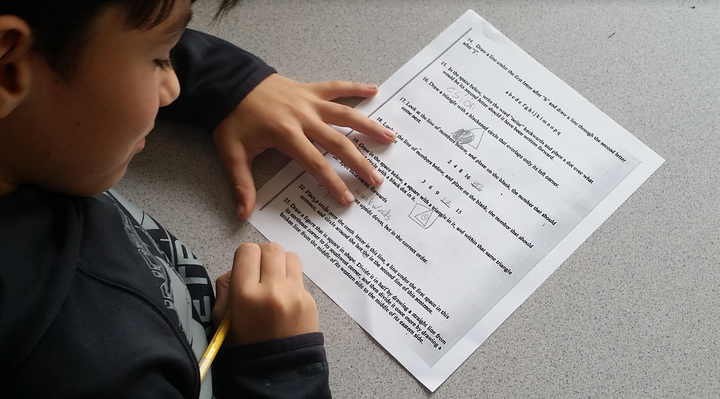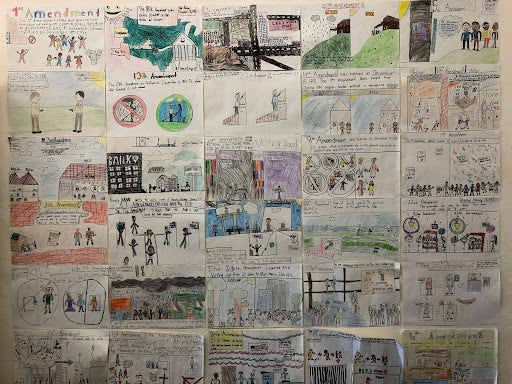
Take a look at a photo of the 46 U.S. presidents. What do you notice?
When I’d ask my students this at the beginning of each school year, someone always said they look old. Another would point out that most of them aren’t smiling, and I’ll never forget the boy who said matter-of-factly that a lot of them are not handsome.
Students would also realize they’re all men, and, except for President Barack Obama, they’re all white. I’d then ask the natural follow-up questions: Why do you think that is and how do you think it’s affected our country? After discussing with a partner, they’d suggest that only white men were allowed to vote (previously true), while another would theorize the elected leaders made laws that favored white men (mostly true, specifically the wealthy). Like our presidents, almost every student in my class was white.
To be clear, this is not critical race theory, despite what many conservatives will have you believe. They argue that teaching kids about race sows segregation and shame, even if the history lesson involves events long before they were born. Some critics go so far as to claim we live in a colorblind society where racism no longer exists, citing Oprah and Obama as proof everyone has a fair shot at success. Many of those critics also have children who are likely to adopt their views, unless professional educators teach them to think for themselves.
I was one of those kids, a Xennial growing up lower-middle class in a small New Hampshire city with my parents and younger brother. In 1990, the state was 98% white. In my high school graduating class of 264, only three students were nonwhite. Needless to say, I was not exposed to meaningful discussions about race. Instead, my family was indoctrinated by Rush Limbaugh, whose radio show provided a soundtrack for our home. My Republican father criticized affirmative action because it gave minority groups an unfair advantage in a country where, he claimed, everyone has an equal opportunity “as long as they work hard.” My mother, a French immigrant, adopted his views by osmosis. I did too, and held on to them throughout my 20s, until one professor changed everything.
While obtaining my master’s degree in education in 2009, I was required to take a course called “Language, Power and Democracy.” The monthlong class explored white privilege and America’s ongoing racial divide, and was taught mostly through documentaries and discussions. Redlining and Reconstruction were just some of the topics covered. My belief that class outweighed race in determining opportunities began to erode. After a month of evidence-based lectures and thoughtful conversations with my racially diverse classmates, I began to see America’s institutional racism.
Upon graduating, I taught at an independent school in San Francisco for nearly a decade. Autonomy over the curriculum allowed me to incorporate current events and marginalized voices into developmentally appropriate fourth grade content. Drawing inspiration from my graduate course, as well as authors Howard Zinn and James Loewen, I provided various perspectives while teaching social studies.
Each October, my students reviewed what they learned in third grade about Christopher Columbus. Then I would read “Encounter” to provide them with a different point of view. The children’s book is told through the eyes of a young Taino boy recounting the Italian explorer’s arrival, and the ensuing enslavement and brutality he unleashed on the native people. My students were simultaneously fascinated and shocked, leading most to write essays about why Columbus Day should no longer be celebrated.
During our World War II unit, students questioned a U.S. propaganda video, then analyzed photos of Japanese Americans being forcibly removed from the West Coast and images from the camps where they were incarcerated. They asked how Japanese Americans could be imprisoned based on their ethnicity, and why German Americans were spared the same treatment. This is not critical race theory, but students certainly raised critical questions about race in American history.

Students learned about the Greensboro Four, Bloody Sunday and the Birmingham Children’s March during our study of the civil rights movement. They empathized with Ruby Bridges and drew inspiration from the Little Rock Nine. They compared old photos of segregated Black and white schools, wondering how anyone could claim they were “separate, but equal.” Students even tackled the Louisiana literacy test, which was given to would-be Black voters in the 1960s. Every student failed. The ensuing conversation led them to draw parallels between past and present, comparing literacy tests and poll taxes to current voter-ID laws and the disenfranchisement of people convicted of felonies in certain states.
The unit’s summative assessment was an essay in which students responded to this prompt: Did the civil rights movement lead to equality for African Americans? They then defended their position during a class debate, and were given the choice to switch sides if they were swayed by an opposing argument. Perhaps Congress would be more effective, and popular, if its members approached debates with the open mind of a 10-year-old.
As disinformation and “alternative facts” divide our country, teaching children how to think for themselves has never been more crucial — even if their conclusions run counter to their parents’ beliefs. Showing kids America’s complete history allows them to see how fear and greed can draw our leaders down dark paths, and how those choices impact people and the planet. If we ignore these missteps to instead focus solely on American exceptionalism, we face future generations of nationalistic leaders preying on voters’ ignorance and xenophobia.
Whitewashing American history lessons parallels Holocaust denialism, and poses a similar threat to the threads of our union. Pushing historical negationism to perpetuate the antiquated goal of a colorblind society only silences the continued macro- and microaggressions and injustices that people of color have endured since our nation’s founding. Kids can handle the truths of history — even if their parents can’t — and benefit from the lesson that criticizing their country doesn’t mean they don’t still love it.
Occasionally, I hear from parents who thank me for teaching their kids America’s history through various lenses. In a recent email, a father wrote that I taught his daughter “history is not black and white, but a wide range of grays, [which] sets a valuable perspective for life and learning.”
This mindset enabled their family to have a nuanced discussion about Afghanistan last year. “It allowed us … to feel OK that we don’t have clear winners and losers, or right and wrong,” he wrote.
Another former student recently said her biggest takeaway was realizing how mistakes by past American leaders helped shape current systemic inequities. Learning about the concept of privilege isn’t about blaming students for actions in the past, she said, but more about understanding how hundreds of years of history have contributed to modern society.
Our nation’s best chance at progress is for professional teachers to shed light on its complicated past while empowering students to formulate their own fact-based opinions ― and politicians shouldn’t be standing in the way. Teaching our youth all of America’s triumphs and failures will empower them as adults to strive toward a more perfect union. A few of those kids may even end up with their photos alongside our past presidents. And if they ascend to leadership, they’ll be far more prepared than their predecessors to ensure our country is working for everyone.
Justin Mazzola incorporated diversity and social justice into his curriculum for nearly a decade before leaving the classroom to seek new challenges. He now works as a freelance writer focusing on creative nonfiction and children’s books. He holds degrees in education and journalism, and is proud of his years serving the country with AmeriCorps. He lives in San Francisco. You can read more of his work at www.justinmazzola.com.
Do you have a compelling personal story you’d like to see published on HuffPost? Find out what we’re looking for here and send us a pitch.
